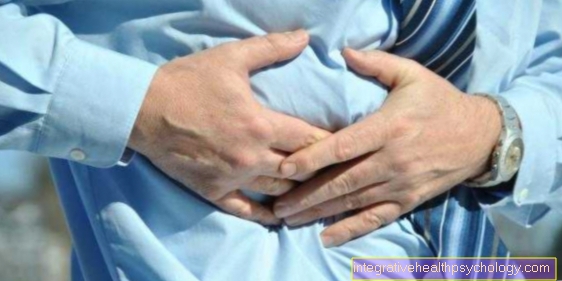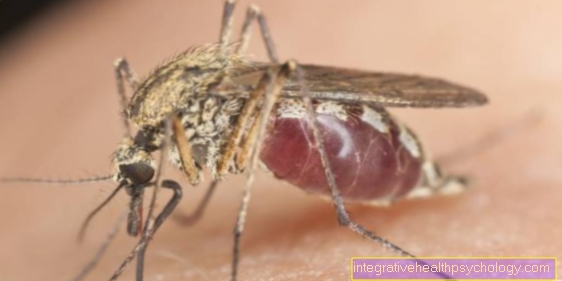Task of enzymes in the human body
introduction
Enzymes are so-called Biocatalysts, without whose help no regulated and efficient metabolism could take place. You can often recognize them by the ending -aseindicating that the substance in question is an enzyme. In some cases, however, enzymes also have names chosen randomly or historically, which do not allow any conclusions to be drawn. They are divided into six main classes depending on the chemical reaction they catalyze. Enzymes are involved in metabolic processes in the cell, i.e. energy generation, energy release, remodeling processes and substrate conversions. But they also play a crucial role in digestion.
Here you can find more general information about Enzymes.

What enzymes are there?
In view of the fact that enzymes are involved in every chemical reaction in the metabolism, in digestion and also in the reproduction of genetic information, it is hardly surprising that over 2000 different enzymes are known to date. In the course of current and future research, one or the other enzyme will probably be added. The biocatalysts are divided into six main classes and a large number of sub-classes. An enzyme is classified and named based on the type of chemical reaction it is involved in. Some enzymes can be assigned to more than one class because they support not just one but several similar reactions. A distinction is made between oxidoreductases, transferases, hydrolases, lyases, isomerases and ligases. They can also be classified according to their structure and the additional materials they need to function. Some enzymes are so-called pure protein enzymes. You do not need any other substances and can catalyze the reaction on your own. Others, on the other hand, need cofactors and coenzymes that bind to them temporarily or permanently and help to implement the reaction. The latter are also called Holoenzymes called, built up from the actual enzyme (Apoenzyme) and the coenzyme or substrate.
general tasks
Enzymes are biological catalysts, in a nutshell too Biocatalysts called. A catalyst is a substance that is able to reduce the so-called activation energy of a reaction. Colloquially, this means that a chemical reaction needs less energy to start and run. In addition, the use of catalysts means that a reaction can take place more quickly. Without enzymes, the human metabolism would not be nearly as fast and, above all, effective. Without enzymes, humans could not exist in the form in which we do it. Enzymes are usually proteins. Only a few enzymes involved in genetic reproduction are so-called Ribozymes and built up from strands of RNA. By definition, their use does not change or consume catalysts. This means that an enzyme can catalyze a large number of reactions in succession. This in turn saves the organism further energy that does not have to be used for the regeneration of enzymes. In addition, enzymes are reaction specific, which means that they cannot catalyze just any reaction. They are precisely matched to the substances in a reaction. This increases their efficiency. In general, enzymes are involved in the transfer of chemical groups between two different substances, the conversion, as well as the structure and breakdown of individual substances.
Digestive tasks
In order for the nutrients contained in the food to be absorbed, i.e. in the cells of the wall of the small intestine and thus the body, they must first be broken down into their smallest units. The small intestine cells only have receptors for these units. This breakdown is known as digestion. Digestive enzymes play a vital role in digestion. They are produced in glands and then gradually released into the inside of the mouth, stomach, and intestines (secreted). Without digestive enzymes, the nutrients from food cannot get into the body and the body would lack its important energy suppliers.
Fats are mostly in the form of so-called Triglycerides ingested in food. Before absorption, i.e. the absorption of nutrients in the intestinal cells, they have to be broken down into their individual components, the fatty acids. In this way, the fat-soluble vitamins that are stored in the fats are also released and can be absorbed. Multiple sugars and some double sugars also have to be broken down into individual sugar molecules with the help of enzymes. Last but not least, the proteins remain, which are enzymatically broken down into the amino acids from which they are made up.
Also read: What role does elastase play in digestion?
Thanks to the enzyme salivary amylase, the digestion of various polysaccharides begins in the mouth. The enzyme pepsin, which digests proteins, is added to the chyme in the stomach. But the majority of digestion takes place in the small intestine. The enzymes that do their work in the small intestine are produced in the pancreas. A passage from the pancreas leads to the beginning of the small intestine, where the enzymes are mixed with the food. In the course of the small intestine, the individual building blocks, the fatty acids, vitamins, amino acids and sugar molecules can then be absorbed.
A total of eight different enzymes are mainly used in the small intestine. Trypsin and chymotrypsin split proteins and long amino acid chains into short amino acid chains.
For more information, see: Chymotrypsin - What Is It Important For?
The carboxypeptidases A and B in turn break down the short amino acid chains into separate amino acids. The lipase also needs bile acids and a co-lipase for its function. With their help, she breaks down triglycerides into fatty acids. Cholesterol esterase also needs bile acids. As its name suggests, it separates cholesterol from fats. In addition to the cholesterol, other fatty acids are also released. The alpha amylase is similar to the one that converts in the mouth Strength in Maltose (a double sugar) around. Food also always contains strands of DNA as a carrier of genetic information. They do not serve humans as energy suppliers, but provide important building blocks for the production of DNA molecules. In this way, the body saves valuable energy that it does not have to invest in the complete new synthesis of these building blocks. The responsible enzymes are the ribonuclease and deoxyribonuclease.
You might also be interested in:
- Digestive tract
- Carboxypeptidase
Role of enzymes in the stomach
The digestive enzyme pepsin is mainly found in the stomach. It is produced by the main cells of the stomach lining in the form of the precursor pepsinogen. Only the acidic pH value in the gastric juice then leads to the conversion of pepsinogen into pepsin. This prevents the pepsin from already acting in the cells of the gastric mucosa and from digesting the body itself. Pepsin splits proteins into peptides, i.e. shorter amino acid chains. Only in the small intestine are the chains broken down into the actual amino acids. Pepsin requires chloride as a cofactor. As one of the few digestive tract enzymes, it can work in acidic gastric juice. Many other enzymes require an alkaline environment in order to be effective.
The enzymes gastric lipase, amylase and gelatinase are also found in small amounts in the stomach. The gastric lipase breaks down fatty acids from fats, the amylase maltose from starch and the gelatinase gelatin. Gelatine is animal collagen that is ingested, for example, with meat or sweets containing gelatine. It is made up of proteins. Ultimately, the gelatinase also releases amino acids.
Functions of enzymes in the blood
Blood is the so-called liquid organ. It is used to transport oxygen to the cells and remove carbon dioxide to the lungs. But other substances and molecules also use the blood to get from one organ to the next. Therefore, a distinction must be made between enzymes that are in the blood whether they are so-called plasma-specific (= blood-specific) enzymes or just "enzymes in transit". Plasma-specific enzymes not only use the blood as a transport medium, but are actually used in the blood. These include enzymes that are involved in blood clotting and enzymes involved in fat and cholesterol metabolism.
One of the plasma-specific enzymes is lipoprotein lipase, which sits on the cell walls of blood vessels. Lipoproteins serve as a means of transport for fatty acids in the blood. So that they can be taken up again into the cells, they have to be released from the lipoproteins by the lipoprotein lipase.
Lecithin-cholesterol acyltransferase is also involved in fat and cholesterol metabolism. It sits on the outside of a certain type of lipoprotein and enables them to absorb free cholesterol from the blood.
Functions of enzymes in saliva
About 1 to 1.5 liters of saliva are produced every day. The smell or the sight of food alone stimulates education. As the first section of the gastrointestinal tract, the mouth is also involved in digestion. This is why saliva already contains a digestive enzyme, amylase. A distinction is made between a so-called alpha and beta amylase. Both break down polysaccharides into small glucose molecules.
A polysaccharide is made up of many individual sugar molecules. For example, the so-called starch from potatoes or bread is such a multiple sugar. It is broken down with the help of amylase into maltose, which consists of two glucose molecules. This first step in digestion is necessary so that the sugar molecules can later be better digested in the stomach and absorbed in the intestine. In addition, starch is a very good source of energy because it contains a lot of energy with little weight. To make this benefit palatable to the brain, the amylase breaks down the rather tasteless starch into sweet maltose, whereupon the brain demands more. You can also try this effect at home: If you chew a piece of bread 20-30 times, it starts to taste much sweeter after a certain time than at the beginning.
Learn more about
- Alpha amylase
and - Alpha-glucosidase



























.jpg)

